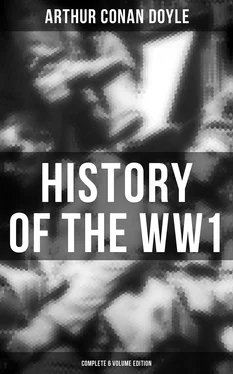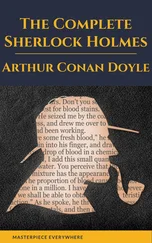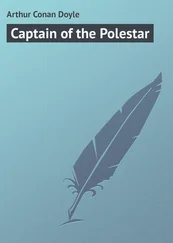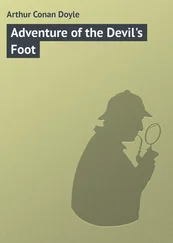To return to the fortunes of the men retreating from Le Cateau, the colonels and brigadiers had managed to make order out of what was approaching to chaos on the day that the troops left St. Quentin. The feet of many were so cut and bleeding that they could no longer limp along, so some were packed into a few trains available and others were hoisted on to limbers, guns, wagons, or anything with wheels, some carts being lightened of ammunition or stores to make room for helpless men. In many cases the whole kits of the officers were deliberately sacrificed. Many men were delirious from exhaustion and incapable of understanding an order. By the evening of the 27th the main body of the troops were already fifteen miles south of the Somme river and canal, on the line Nesle—Ham—Flavy. All day there was distant shelling from the pursuers, who sent their artillery freely forward with their cavalry.
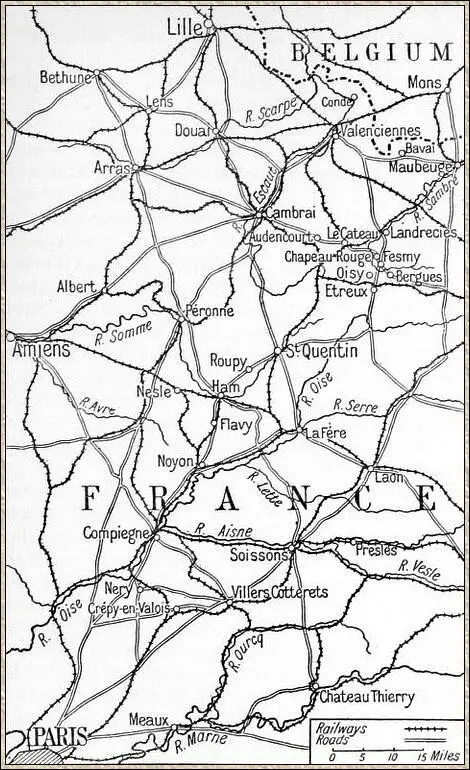
Line of Retreat from Mons
On the 28th the Army continued its retreat to the line of the Oise near Noyon. Already the troops were re-forming, and had largely recovered their spirits, being much reassured by the declarations of the officers that the retreat was strategic to get them in line with the French, and that they would soon turn their faces northwards once more. As an instance of reorganisation it was observed that the survivors of a brigade of artillery which had left its horses and guns at Le Cateau still marched together as a single disciplined unit among the infantry. All day the enemy’s horse artillery, cavalry, and motor-infantry hung on the skirts of the British, but were unable to make much impression. The work of the Staff was excellent, for it is on record that many of them had not averaged two hours’ sleep in the twenty-four for over a week. the Army.
On the next day, the 29th, the remainder of the Army got across the Oise, but the enemy’s advance was so close that the British cavalry was continually engaged. Gough’s 3rd Cavalry Brigade made several charges in the neighbourhood of Plessis, losing a number of men but stalling off the pursuit and dispersing the famous Uhlans of the Guard. On this day General Pulteney and his staff arrived to take command of the Third Army Corps, which still consisted only of the Fourth Division (Snow) with the semi-independent 19th Infantry Brigade, now commanded by Colonel Ward, of the 1st Middlesex. It was nearly three weeks later before the Third Corps was made complete.
There had been, as already mentioned, a French advance of four corps in the St. Quentin direction, which fought a brave covering action, and so helped to relieve the pressure upon the British. It cannot be denied that there was a feeling among the latter that they had been unduly exposed, being placed in so advanced a position and having their flank stripped suddenly bare in the presence of the main German army. General Joffre must have recognised that this feeling existed and that it was not unreasonable, for he came to a meeting on this day at the old Napoleonic Palace at Compiègne, at which Sir John French, with Generals Haig, Smith-Dorrien, and Allenby, was present. It was an assemblage of weary, overwrought men, and yet of men who had strength enough of mind and sufficient sense of justice to realise that whatever weight had been thrown upon them, there was even more upon the great French engineer, whose spirit hovered over the whole line from Verdun to Amiens. Each man left the room more confident of the immediate future. Shortly afterwards Joffre issued his kindly recognition of the work done by his Allies, admitting in the most handsome fashion that the flank of the long French line of armies had been saved by the hard fighting and self-sacrifice of the British Army.
On August 30, the whole Army having crossed the Oise, the bridges over that river were destroyed, an operation which was performed under a heavy shell fire, and cost the lives of several sapper officers and men. No words can exaggerate what the Army owed to Wilson’s sappers of the 56th and 57th Field Companies and 3rd Signal Company, as also to Tulloch’s, of the 17th and 59th Companies and 5th Signal Company, whose work was incessant, fearless, and splendid.
The Army continued to fall back on the line of the Aisne, the general direction being almost east and west through Crépy-en-Valois. The aeroplanes, which had conducted a fine service during the whole of the operations, reported that the enemy was still coming rapidly on, and streaming southwards in the Compiègne direction. That they were in touch was shown in dramatic fashion upon the early morning of September 1. The epic in question deserves to be told somewhat fully, as being one of those incidents which are mere details in the history of a campaign, and yet may live as permanent inspirations in the life of an army.
The 1st Cavalry Brigade, greatly exhausted after screening the retreat so long, was encamped near Néry, to the south of Compiègne, the bivouac being a somewhat extended one. Two units were close to each other and to the brigade headquarters of General Briggs. These were the hard-worked 2nd Dragoon Guards (the Bays) and L Battery of Horse Artillery. Reveille was at four o’clock, and shortly after that hour both troopers and gunners were busy in leading their horses to water. It was a misty morning, and, peering through the haze, an officer perceived that from the top of a low hill about seven hundred yards away three mounted men were looking down upon them. They were the observation officers of three four-gun German batteries. Before the British could realise the situation the guns dashed up and came into action with shrapnel at point-blank range. The whole twelve poured their fire into the disordered bivouac before them. The slaughter and confusion were horrible. Numbers of the horses and men were killed or wounded, and three of the guns were dismounted. It was a most complete surprise, and promised to be an absolute disaster. A body of German cavalry had escorted the guns, and their rifles added to the volume of fire.
It is at such moments that the grand power of disciplined valour comes to bring order out of chaos. Everything combined to make defence difficult —the chilling hour of the morning, the suddenness of the attack, its appalling severity, and the immediate loss of guns and men. A sunken road ran behind the British position, and from the edge of this the dismounted cavalrymen brought their rifles and their machine-gun into action. They suffered heavily from the pelting gusts of shrapnel. Young Captain de Crespigny, the gallant cadet of a gallant family, and many other good men were beaten down by it. The sole hope lay in the guns. Three were utterly disabled. There was a rush of officers and men to bring the other three into action. Sclater-Booth, the major of the battery, and one lieutenant were already down. Captain Bradbury took command and cheered on the men. Two of the guns were at once put out of action, so all united to work the one that remained.

“L” Battery Action, September 1, 1914
What followed was Homeric. Lieutenant Giffard in rushing forward was hit in four places. Bradbury’s leg was shattered, but he lay beside the trail encouraging the others and giving his directions. Lieutenant Mundy, standing wide as observation officer, was mortally wounded. The limber could not be got alongside and the shell had to be man-handled. In bringing it up Lieutenant Campbell was shot. Immediately afterwards another shell burst over the gun, killed the heroic Bradbury, and wounded Sergeant Dorell, Driver Osborne, and Gunners Nelson and Derbyshire, the only remaining men. But the fight went on. The bleeding men served the gun so long as they could move, Osborne and Derbyshire crawling over with the shells while Nelson loaded and Dorell laid. Osborne and Derbyshire fainted from loss of blood and lay between limber and gun. But the fight went on. Dorell and Nelson, wounded and exhausted, crouched behind the shield of the thirteen-pounder and kept up an incessant fire. Now it was that the amazing fact became visible that all this devotion had not been in vain. The cluster of Bays on the edge of the sunken road burst out into a cheer, which was taken up by the staff, who, with General Briggs himself, had come into the firing-line. Several of the German pieces had gone out of action. The dying gun had wrought good work, as had the Maxim of the Bays in the hands of Lieutenant Lamb. Some at least of its opponents had been silenced before the two brave gunners could do no more, for their strength had gone with their blood. Not only had the situation been saved, but victory had been assured.
Читать дальше
